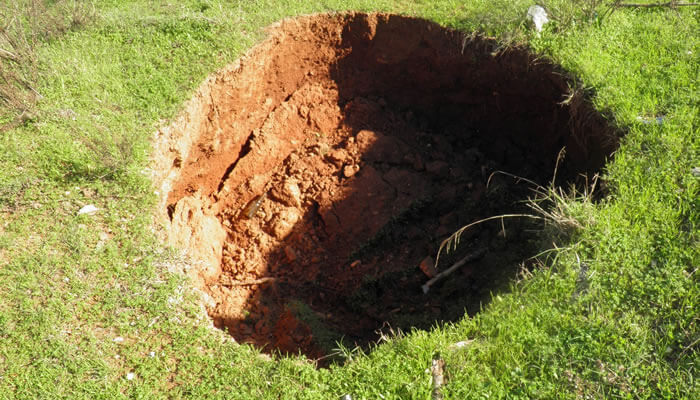Florida is replete with sinkholes. Why? Because the entire state has an underlying layer of carbonate rock, which, when mixed with the acidity from rainwater, erodes quicker than many other ground substances. Therefore, in theory, the entire Florida region is at risk for sinkholes. However, certain regions have a considerably higher risk than others, particularly those with limestone bases. (You can assess your worry factor by checking out the Dept. of Geology’s 2014 Florida Sinkhole Map, here.)
Feeling a little anxious, now? On the one hand, no one wishes for sinkhole problems – they can be highly dangerous, even causing fatalities. In addition to possible danger, you need to be aware of the structural status of your property – after all, who should pay for the repairs? Specifically, if your home, office, or other property ends up with structural damage, you will need to find out whether the cause was a sinkhole in order to pursue insurance coverage.
Below are warning signs and instructions for sinkholes.
Sinkhole Warning Signs
The Southwest Florida Water Management District provides a guide to sinkhold warning signs, as follows:
- Structural cracks – wall cracks, floor cracks, and pavement cracks.
- Ground surface cracks.
- Fence posts, home foundations, or trees start to look brightly new at the bottom, just above ground.
- Trees, fence posts, yard sundials, garden sculptures, or other objects embedded in the ground start to slump, sag, or slant.
- Windows or doors need adjusting in order to close properly.
- Ponds start to form where they had not been before. Called ponding, you’ll start to see small ponds of collected rainfall.
- Circular areas of vegetation start to wilt, whereas before it would grow fine.
- Well water starts to look murky or grey.
What to Do?
If you see any of these warning signs, rope off the area, and call your insurance adjuster immediately. If the warning signs are inside the home, you may need to evacuate. Here are an additional two key instructions from the Florida Dept. of Environmental Protection:
1. If the hole is directly impacting a house, and sinking, sagging, or cracking walls are apparent, stay out of the dwelling.
2. Report the incident to the appropriate Subsidence Incident Report Form and submitted to the Florida Geological Survey.
Many Florida sinkholes are not dangerous – they are just part of the natural landscape, and can be filled with clayey sand in order to impede further water movement in the area. But it’s hard to distinguish, so it’s best to leave the area alone until you get an expert opinion. Call LMR Public Adjusters to assess your particular situation – better safe than sorry.




